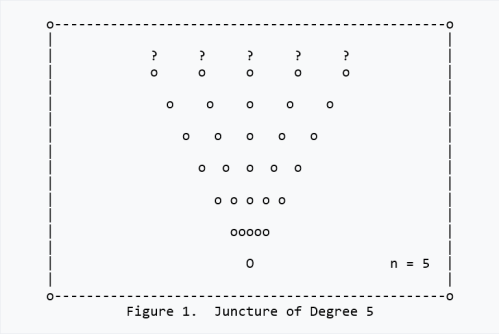What is information that a sign may bear it?
Three more questions arise at this juncture.
- How is a sign empowered to contain information?
- What is the practical context of communication?
- Why do we care about these bits of information?
A very rough answer to these questions might begin as follows.
Human beings are initially concerned solely with their own lives but then a world obtrudes on their subjective existence and so they find themselves forced to take an interest in the objective realities of its nature.
In pragmatic terms our initial aim, concern, interest, object, or pragma is expressed by the verbal infinitive to live, but the infinitive is soon reified into the derivative substantial forms of nature, reality, the world, and so on. Against that backdrop we find ourselves cast as the protagonists on a scene of uncertainty.
The situation may be pictured as a juncture from which a manifold of options fan out before us. It may be an issue of “truth”, “duty”, or “hope”, the last codifying a special type of uncertainty as to what regulative principle has any chance of success, but the chief uncertainty is that we are called on to make a choice and all too often we have very little clue which of the options is most fit to pick.
Just to make up a discrete example, let us suppose the cardinality of the choices before us is a finite integer and just to make it fully concrete let us say
Figure 1 affords a rough picture of the situation.
This pictures a juncture, represented by a node marked where there are
options for the outcome of a conduct and we have no clue as to which it must be. In a sense the degree of the node, in this case
measures the uncertainty we have at that point.
The Figure illustrates the minimal sort of setting in which a sign can make any sense at all. A sign has significance for an agent, interpreter, or observer because its actualization, its being given or its being present, serves to reduce the uncertainty of a decision the agent has to make, whether it concerns the actions the agent ought to take in order to achieve some objective of interest, or whether it concerns the predicates the agent ought to treat as being true of some object or situation in the world.
cc: FB | Semeiotics • Laws of Form • Mathstodon • Ontolog • Academia.edu
cc: Conceptual Graphs • Cybernetics • Structural Modeling • Systems Science


Pingback: Survey of Pragmatic Semiotic Information • 8 | Inquiry Into Inquiry